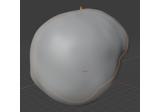mne.write_surface#
- mne.write_surface(fname, coords, faces, create_stamp='', volume_info=None, file_format='auto', overwrite=False, *, verbose=None)[source]#
Write a triangular Freesurfer surface mesh.
Accepts the same data format as is returned by read_surface().
- Parameters:
- fnamepath-like
File to write.
- coords
array, shape=(n_vertices, 3) Coordinate points.
- faces
intarray, shape=(n_faces, 3) Triangulation (each line contains indices for three points which together form a face).
- create_stamp
str Comment that is written to the beginning of the file. Can not contain line breaks.
- volume_infodict-like or
None Key-value pairs to encode at the end of the file. Valid keys:
‘head’ : array of int
‘valid’ : str
‘filename’ : str
‘volume’ : array of int, shape (3,)
‘voxelsize’ : array of float, shape (3,)
‘xras’ : array of float, shape (3,)
‘yras’ : array of float, shape (3,)
‘zras’ : array of float, shape (3,)
‘cras’ : array of float, shape (3,)
New in v0.13.0.
- file_format‘auto’ | ‘freesurfer’ | ‘obj’
File format to use. Can be ‘freesurfer’ to write a FreeSurfer surface file, or ‘obj’ to write a Wavefront .obj file (common format for importing in other software), or ‘auto’ to attempt to infer from the file name. Defaults to ‘auto’.
New in v0.21.0.
- overwritebool
If True (default False), overwrite the destination file if it exists.
- verbosebool |
str|int|None Control verbosity of the logging output. If
None, use the default verbosity level. See the logging documentation andmne.verbose()for details. Should only be passed as a keyword argument.
See also
